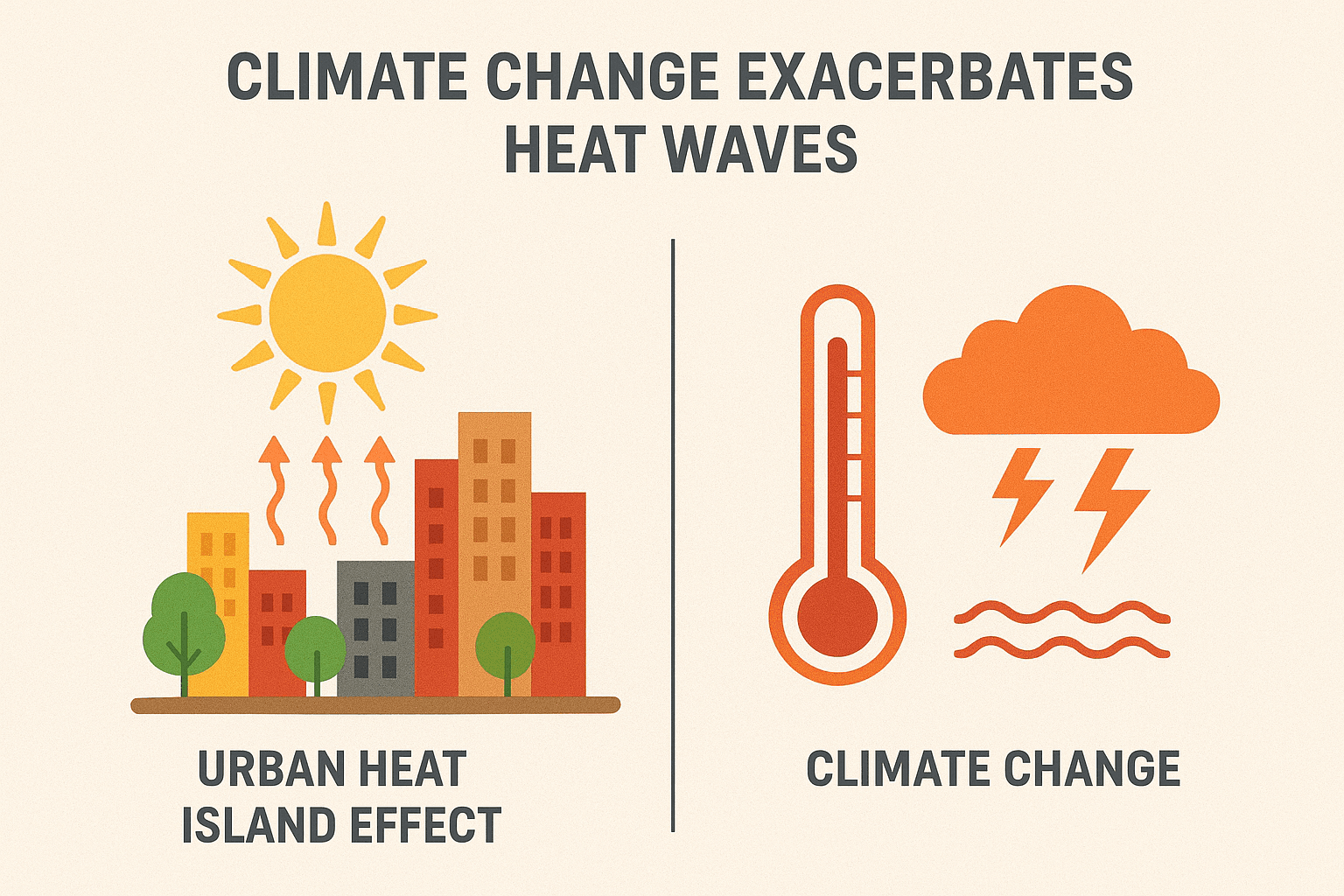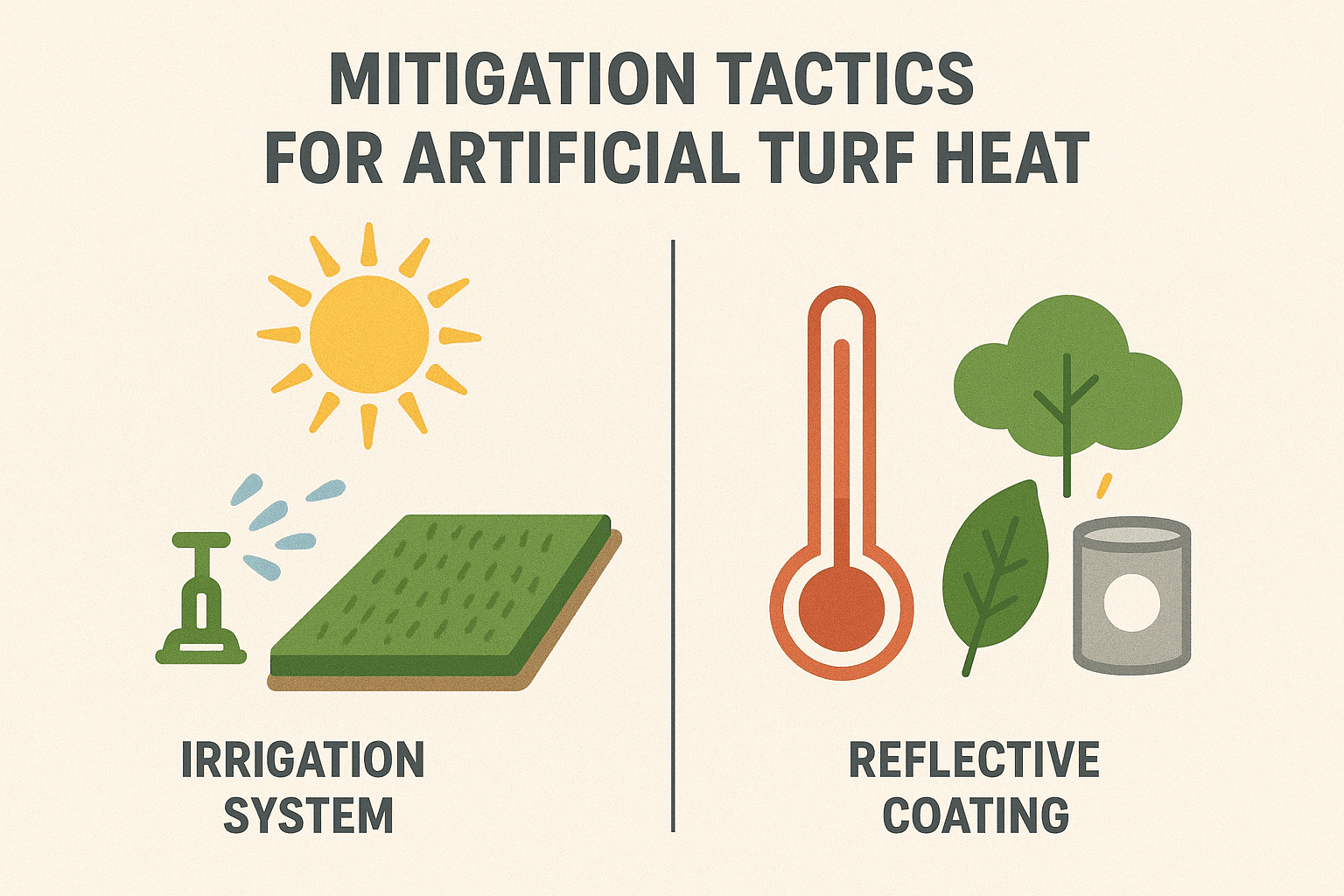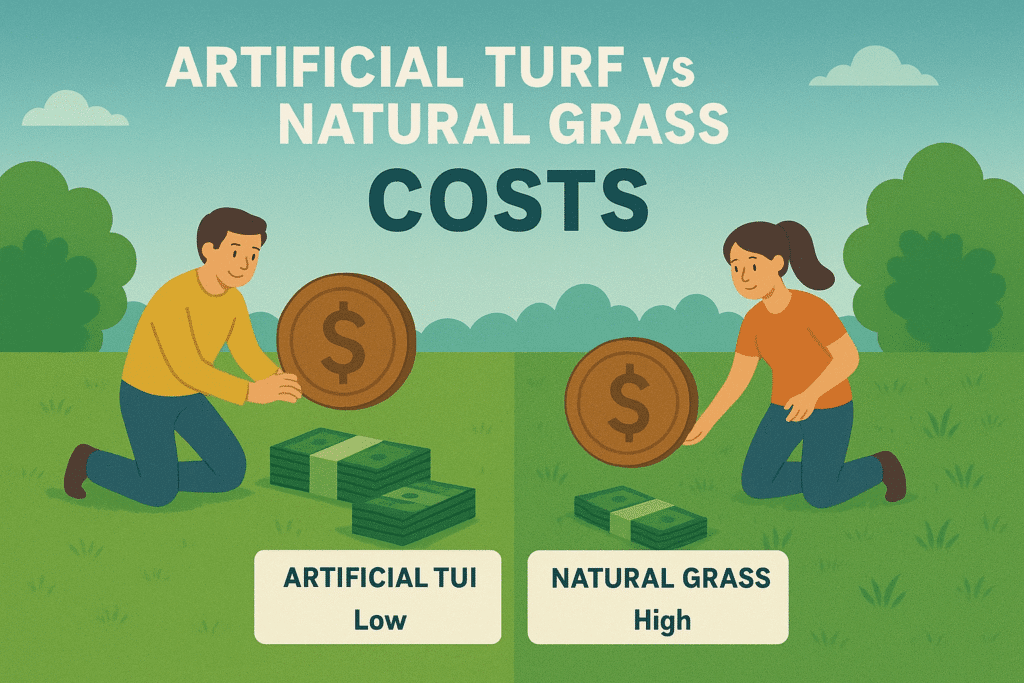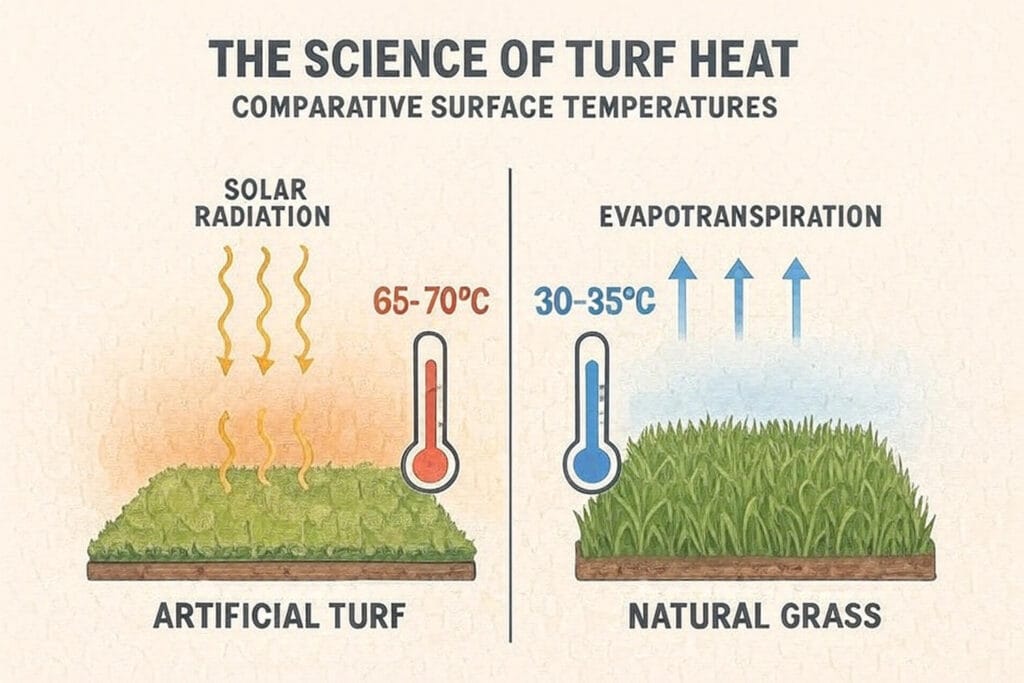
Table of Contents
ToggleWhat is Artificial Turf heat island effect?
Artificial turf may look like a simple replacement for natural grass right ? But actually, in cities it plays a surprising role in intensifying the Urban Heat Island (UHI) effect. Imagine a summer afternoon in a crowded park. You found that shaded lawns stay relatively cool compared to synthetic turf fields. Sometimes their surface temperatures reached above 60-70°C. This hidden heat raises discomfort and health risks for communities.
The UHI effect happens when city surfaces like asphalt, rooftops and artificial turf trap and re-radiate heat. Unlike natural grass which cools the air through transpiration, turf is made of plastics and rubber infills that absorb solar radiation. As a result these turf contributes to hotter climates, reduce nighttime cooling and greater energy demand in surrounding buildings.
Many studies across the world show that densely built cities experience surface temperature differences of 5-7°C compared to nearby rural areas. In addition, artificial turf adds another layer to this problem. Its widespread use in playgrounds, stadiums and housing complexes causes the issues that affect millions of people daily.
By recognising the artificial turf heat island effect earlier our urban planners and communities can better understand its causes and prepare effective solutions. Tackling this hidden source of urban heat is a critical step towards building healthier and climate-resilient cities.

Why Does Artificial Turf Amplify Urban Heat? Root causes
Artificial turf is marketed as a low-maintenance and evergreen alternative to natural grass but its hidden downside lies in how it traps and radiates heat. Understanding the science behind this can help us to explain why synthetic surfaces become dangerously hot in cities and how they intensify the artificial turf heat island effect. According to the U.S. Environmental Protection Agency (EPA), urban surfaces such as asphalt and synthetic turf can reach summertime surface temperatures of 48–67°C (120–150°F) which is significantly higher than natural grass.
Solar Absorption Mechanics
Artificial turf is made from plastic polymers like polyethylene and polypropylene. These materials have a low reflectivity (albedo) which means they absorb most of the incoming solar radiation instead of reflecting it back. On a sunny day, turf can heat up 35 to 60% more than natural gas. It is found that sometimes these surfaces may exceed 70°C which is too hot. This high absorption makes turf fields feel like radiant heat sources which contribute directly to urban warming.
Absence of Evapotranspiration
Natural grass cools the surrounding air through transpiration in which plants release moisture that reduces local temperatures. Yet artificial turf lacks this cooling process. Without living roots and water circulation, the surface becomes a “heat sponge.” At last nearby air temperature rises by several degrees which increases discomfort for athletes, pedestrians and residents.
Infill’s Heat-Trapping Role
Most turf systems use crumb rubber or sand as infill to keep blades upright. These dark colored particles act like miniature heat reservoirs. Once they’re heated, they slowly release stored energy to keep the surface hot for a longer time. This prolonged heat release reduces nighttime cooling in cities which is a key factor behind the persistence of the urban heat Island effect.
Surface Density and Airflow Reduction
Artificial turf installations are often paired with concrete or fencing to create zones with reduced airflow. The dense and impermeable surface prevents natural cooling from wind circulation or moisture exchange. This combination amplifies heat retention and makes turf heavy spaces that are significantly warmer than their green counterparts.
Albedo Differences Across Materials
Natural grass reflects about 25-30% of sunlight but artificial turf’s albedo is often below 15%. This contrast may sound small to you but across large sports complexes or playgrounds, it results in massive additional heat storage. The darker the turf color, the stronger the heat absorption. I mean, black or dark green turf will absorb most heat.
Artificial turf heats up due to its material composition, lack of transpiration and heat-trapping infills. These factors together intensify the urban heat Island effect which raises health risks, stresses local ecosystems and increases cooling costs. To recognise these root causes is essential for developing practical mitigation strategies.

How Urban Design and climate Factors Worsen this issue more?
Artificial turf heat island problems aren’t the only thing. Urban design choices and climate conditions make them even worse. Dense city layouts that are filled with high-rise buildings and asphalt streets limit natural airflow and trap heat in pockets where turf is installed.
This issue is also complemented by pollution. Smog and particulate matter interact with heat-retaining surfaces like turf to form low-level ozone that worsens air quality during heat waves. Those cities that are already facing more frequent and intense heat events find turf installations as amplifiers that push ground-level temperatures even higher.
Regional differences are significant. In arid cities like Phoenix, turf heats faster due to intense solar radiation but in humid cities like Mumbai, these turfs combine with high moisture levels and create unbearable thermal discomfort. These environmental triggers ensure artificial turf doesn’t just get hot — it should actively intensify broader urban heat vulnerabilities.
Health, Ecological and Economic Impacts
The artificial turf heat island effect carries real costs across our society. For human health the surface temperatures above 60°C can cause heat stress, burns and dehydration for athletes and children playing on fields. Elderly humans or those with respiratory issues are vulnerable groups, they face heightened risks when urban turf raises local air temperatures.
Ecologically, hotter microclimates around turf reduce biodiversity. Soil organisms, pollinators and even urban trees nearby struggle with heat-stressed conditions which lead to imbalances in local ecosystems. Turf also prevents natural groundwater recharge.
Economically, higher urban heat results in greater energy consumption. Buildings near artificial turf fields often require more air conditioning which increases utility bills and carbon emissions. Municipalities bear the costs of turf cooling systems or early replacement because surfaces often degrade faster under extreme heat.
In short, artificial turf may save on mowing and watering but the hidden health, ecological and financial burdens often outweigh these short-term benefits which makes its long-term sustainability questionable..

Cooling solutions of Artificial Turf heat island
Artificial turf may trap heat but a variety of proven mitigation methods can reduce its temperature and overall impact on the urban heat island effect. These solutions (from material innovations to smarter design) offer both short-term relief and long-term sustainability.
Advanced and Organic Infills
Traditional crumb rubber is one of the biggest heat trappers in turf systems. Replacing it with organic or mineral-based infills such as cork, coconut fibers or coated sand, can significantly lower the surface temperatures. These natural materials have higher moisture retention and lighter colors which improve cooling and maintain playability.
Irrigation and Cooling Systems
Periodic watering can temporarily cool turf surfaces by 10-20°C. Some modern installations include built-in misting or subsurface irrigation systems to regulate heat. Although, this adds operational costs and water usage so we should go with recycled or harvested rainwater to make this practice more sustainable.
Reflective Coatings and Light-Colored Fibers
Applying reflective surface coatings or using lighter colored turf blades improves albedo. It reflects more sunlight instead of absorbing it. Though lighter shades may look less “natural” yet they reduce heat absorption and extend the turf’s lifespan by lowering thermal stress.
Hybrid Turf and Shaded Designs
Hybrid models where artificial turf is blended with patches of natural grass can help to create a Balance between durability and cooling. Similarly, to create natural cooling zones and reduce direct solar exposure we can incorporate shade structures, pergolas or strategically planted trees around turf fields.
Smart Monitoring Technologies
Emerging turf systems integrate sensors that track surface temperatures in real-time. These technologies can trigger automated cooling responses such as irrigation or shading mechanisms. In this way we can make maintenance proactive rather than reactive. This ensures player safety for schools and sports facilities during extreme heat events.
Strategic Placement and Urban Planning
The biggest mitigation may come not from the turf but from where it is installed. Avoid turf near heat-sensitive zones like hospitals or schools. This can help to reduce localised heat buildup. No single solution can eliminate turf heat completely but a multi-layered approach can reduce surface temperatures.
FAQs
What is the artificial turf heat island effect?
The artificial turf heat island effect refers to how synthetic grass surfaces absorb and retain more heat than natural grass. This process contributes to higher local temperatures. Natural lawns cool the air through transpiration but turf is made from plastics and infill, which trap heat and make urban areas hotter.
How hot can surfaces get due to the artificial turf heat island effect?
Research shows that artificial turf fields can reach extreme temperatures – sometimes around 48-67°C (120-150°F) in summer. This makes turf fields uncomfortable and even unsafe during peak heat hours, especially for athletes and children.
What are the best solutions to reduce the artificial turf heat island effect?
The best solutions may include – using organic infills like cork or coconut fibers, installation of misting or irrigation systems, applying reflective coatings and designing shaded areas around turf fields. A combination of these approaches may help to reduce surface heat.
